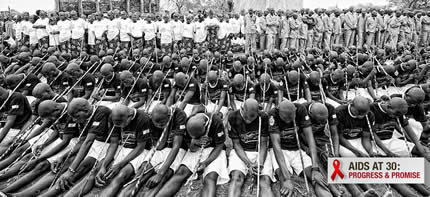Get a bullet-proof vest

Research has shown that the chances of sustaining a shot in the chest are higher compared to a bullet hitting any other part of the body and in the absence of such protection such a shot could prove to be fatal.
If one is hit in the head then the bullet-proof vest ceases to be of any use. So in combat a sniper will even aim below the belt, in the abdomen and such injuries can still be fatal. Despite the fatality of shots in any other parts of the body, it does not take away the importance of a bullet-proof vest in combat.
Male circumcision, like a bullet-proof vest, offers some cover – a greater percentage but not 100 percent.
In studies carried out it was proven that medical male circumcision offered a 60 percent higher protection from HIV infection.
For one to then undergo the procedure and think they have full cover from infection is misguided.
Why medical circumcision, one is bound to ask. Traditionally in Zimbabwe there have been tribes that have practised circumcision for ages and these being the Shangaan and the Remba as part of a rite of passage from boyhood into manhood.
In these procedures, women stay far from the camps only coming in to perform domestic chores, as only circumcised men were allowed to be part of the initiation. A longstanding and invaluable practice indeed, as seen by the lower prevalence rate of HIV in such communities compared to their non-circumcising counterparts.
This shows that if circumcision was not handled as a bridge to misbehave, but rather removed real men from the boys. It came with a responsibility as they camped in winter and were taught the importance of the rite.
Southern Africa is the epicentre of the HIV epidemic and one is bound to ask why that region. It could be attributed to some practices, e.g. polygamy, early marriages, forced marriages and even to some extend the region condones in a way extra-marital affairs. It is common to see a man with a legal wife having three or even four mistresses who are commonly referred to as “small houses”.
North Africa has a low HIV prevalence because Islam is one of the religions that demand all male adherrants are circumcised, usually soon after birth. The first clues that male circumcision came from studies in Tanzania where the population was roughly equally divided between Muslims and Christians.
Although both groups had almost identical lifestyles and roughly the same percentages of men indulging in risky behaviour and monogamy, the Muslim population had a significantly lower HIV rate. In the end maps showing distributions of Muslims were seen to be very close to maps showing intensity of HIV infections.
Male circumcision offers 60 percent protection, and more or less like a bullet-proof vest there still is a 40 percent chance that is not covered and should be of concern.
The country’s goal is to reach 80 percent of 15 to 29- year-old men by 2015 as part of HIV prevention programme through male medical circumcision.
No life has been lost through the medical male circumcision. In the traditional way, a mother bringing food to the collection centre would know that her son had died on bringing the evening meal and finding the early meal untouched. It was sad as bleeding was the main cause of death. But today, the Government has partnered the traditionally circumcising tribes and there have been no loss of lives.
Male circumcision reduces an individual’s biological susceptibility to heterosexually acquired infection.
Male circumcision is to be implemented as part of a comprehensive package of HIV prevention interventions in countries with high HIV prevalence.
Thirteen high burden countries have been selected for support by WHO, these being Botswana, Kenya, Lesotho, Malawi, Mozambique, Namibia, Rwanda, South Africa, Swaziland, Tanzania, Uganda, Zambia and Zimbabwe.
Male circumcision also prevents other STIs, including chancroid, syphilis, human pappiloma virus (HPV), balanitis, phimosis and penile cancer.
HPV is the virus responsible for causing cervical cancer in women. So the benefits of male circumcision cut across as they offer protection to the female, too. So it could be said that MC reduces the chances of getting cervical cancer in the female partner.
In infants the procedure reduces urinary tract infections (in infants) so neo-natal MC is also an added advantage.
Population Services International is supporting the male circumcision programme in Zimbabwe.
In Masvingo Province PSI supports four out seven districts, namely Masvingo, Chivi, Chiredzi and Mwenezi. PSI is pleased that they will scale up the programme with the upcoming winter Shangaan traditional male circumcision set for the school holiday.
In the first quarter of 2013 PSI did the procedure on 680 out of a target of 1500 this was a 45 percent target reached said a report by PSI.
In the second quarter 1 500 men went under the knife out of 1 324 males, showing that the target was surpassed.
The third quarter targets 3 900 men and the fourth quarter targets 2 600 men. These figures can be surpassed with the winter Shangaan circumcision coming soon.
PSI is pleased to announce that not only the target group is able to be attended on the national programme. This group was targeted as they are on the debut of sexual activity at 15 and are on the peak up to 29. Any other males regardless of age are welcome.
The procedure is done nationwide and school holidays are usually targeted as the bulk of their clients are found on holidays.
Dr Owen Mugurungi, the director of Aids and TB Unit in the Ministry of Health and Child Welfare, speaking to journalists recently at a workshop said male circumcision should be taken as part of a package to HIV prevention not as a stand-alone unit.
“MC, like PMTCT, should bring results in the prevention of HIV and it ought to be used as a package. The waiting period of 42 days after the operation allows for total healing of the penis as engaging in this period risks one to bruises thereby increasing the chances of infection,” he said.
Cervical cancer is a leading cause of death in women. If male circumcision reduces the chances of HPV, which is a major cause of cervical cancer, then women are encouraged to accompany their spouses to undergo the procedure.
If women wait for the same period after giving birth and women give birth many more times, men undergo male circumcision only once, then why have you not had the foreskin removed?
Feedback: [email protected]






Comments